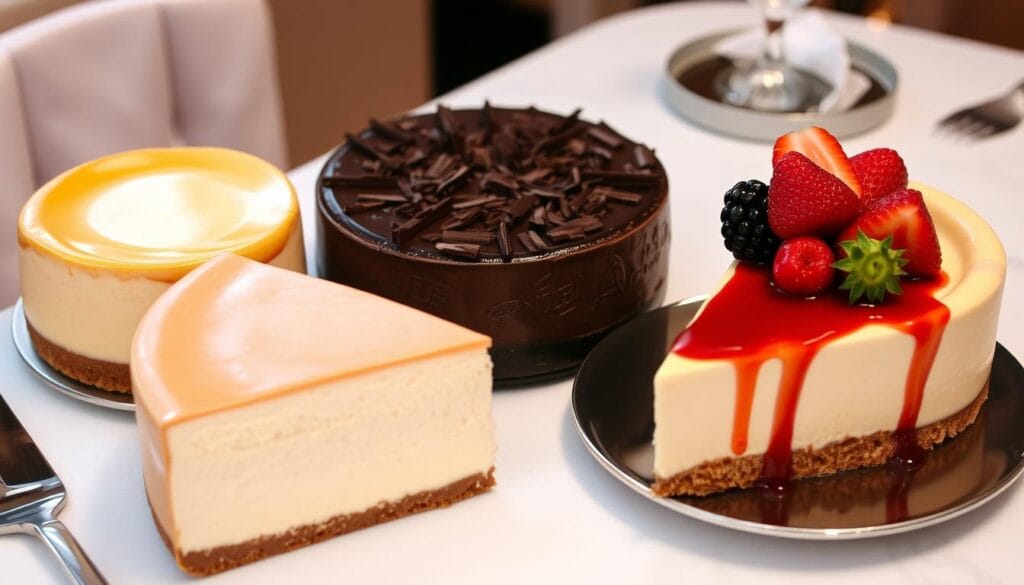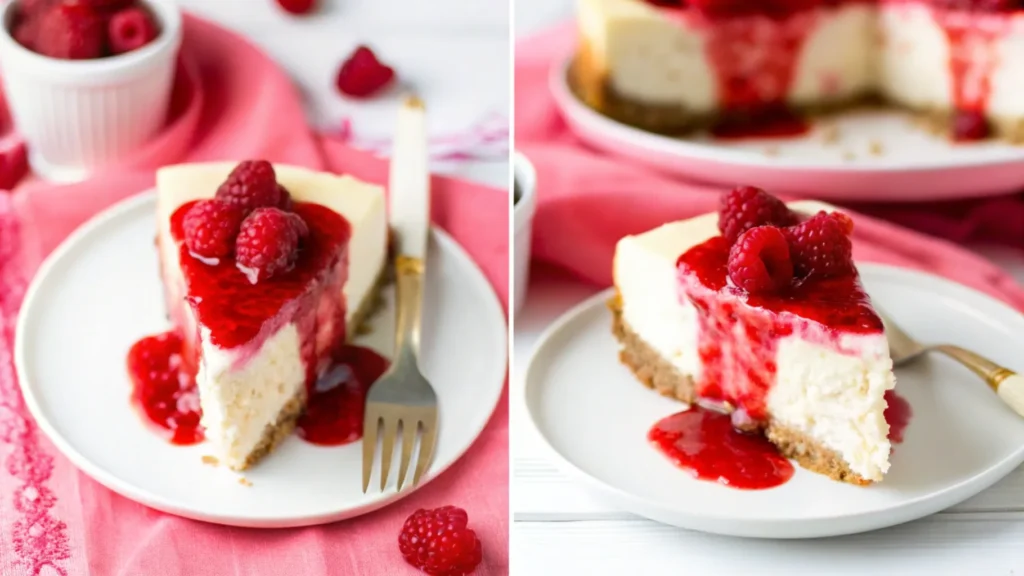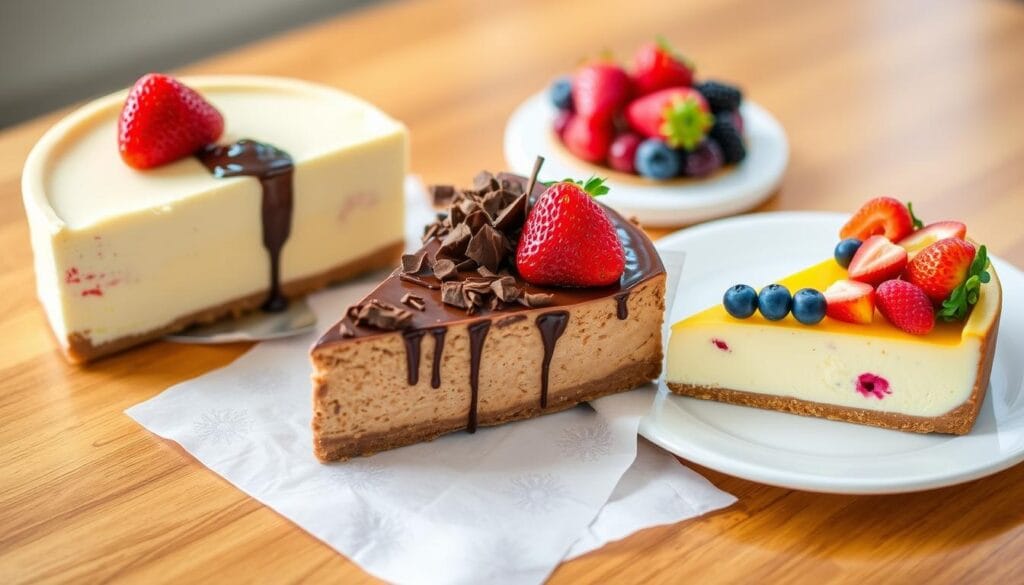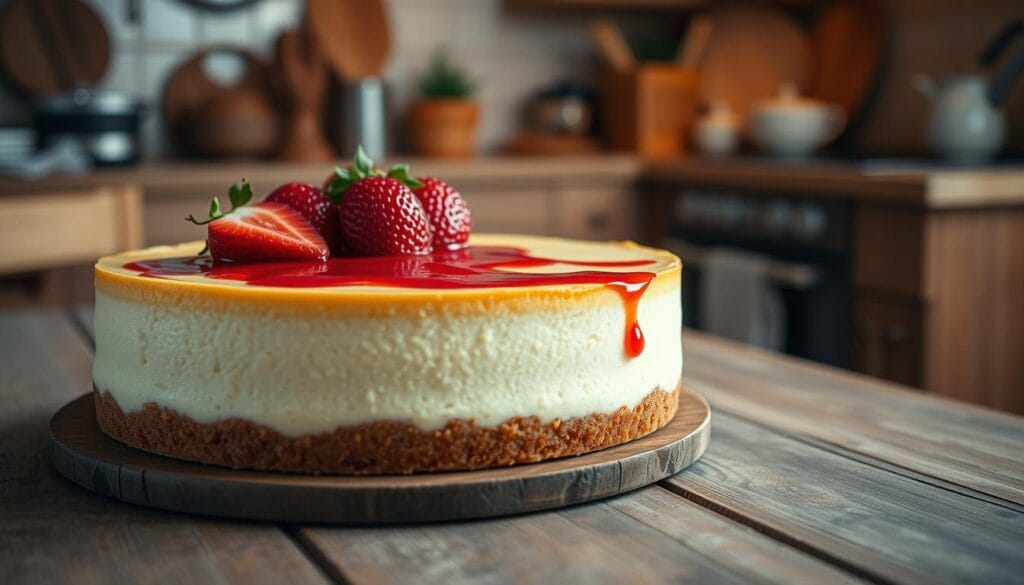
Ever craved a slice of creamy cheesecake but felt lost among the many options? As a dessert lover, I’ve explored the three types of cheesecake. These options turn a simple dessert into a journey of flavors.
Cheesecake’s history goes back to Ancient Greece. It started as a mix of cheese and honey and grew into an art form with many types. Whether you love traditional cheesecakes or want to try new ones, knowing the three main types will make your desserts better.
The three main cheesecake types are New York-style, regular or classic, and no-bake. Each has its own texture, way of making, and taste. They suit different tastes.
Table of contents
Understanding the History of Cheesecake and Its Connection to the Three Types of Cheesecake
Cheesecake’s history is a tasty journey through time. It started as a simple food for ancient Greek athletes. Now, it’s loved worldwide, thanks to cultural exchange and new ideas.

Ancient Origins and Culinary Roots
Ancient Greek desserts were key in cheesecake’s creation. The first cheesecakes were made from cheese, wheat, and honey. These early treats gave athletes energy for their games.
- First recorded cheesecake recipe dates back to 230 AD
- Original ingredients included cheese, wheat flour, and honey
- Served as a nutritious food for athletes and warriors
From Greek Athletes to Global Delicacy
The Romans took cheesecake to Europe, changing it in each place. By the 15th century, “cheesecake” was known in England. This was a big step in its journey.
“Every slice of cheesecake tells a story of centuries of culinary tradition.” – Anonymous Pastry Chef
The Rise of American Cheesecake
In the late 19th century, American cheesecake was born. William A. Lawrence’s cream cheese invention in 1872 changed how cheesecakes were made. Arnold Reuben made the New York-style cheesecake famous in the 1930s.
| Era | Cheesecake Characteristics |
|---|---|
| Ancient Greece | Simple cheese and honey dessert |
| Roman Period | Spread across European regions |
| 19th Century | Cream cheese invention |
| 1930s | New York-style cheesecake popularized |
Today, cheesecake keeps changing, with new flavors from around the world. It shows how food can bring people together.
What Are the Three Types of Cheesecake? A Guide to Their Flavors and Textures
Exploring cheesecake reveals three main varieties that excite our taste buds. Each style has its own texture and flavor, catering to different dessert lovers.

- New York-Style Cheesecake: The quintessential rich and dense variety
- Ultra-creamy texture
- Made with cream cheese and heavy cream
- Typically tall and decadent
- Classic/Regular Cheesecake: A lighter, more versatile option
- Fluffier consistency
- More adaptable to different flavors
- Easier to customize with toppings
- No-Bake Cheesecake: The quick and cool alternative
- No oven required
- Smoother, more homogeneous texture
- Uses gelatin or whipped cream for stabilization
“Cheesecake is not just a dessert, it’s an experience of culinary creativity!” – Pastry Chef
Each cheesecake style brings a unique twist to this beloved dessert. Whether you love the dense New York classic, a lighter traditional version, or a quick no-bake treat, there’s a cheesecake for every taste and occasion.
New York-Style Cheesecake: A Star Among the Three Types of Cheesecake
Authentic New York dessert is all about the legendary New York cheesecake. It’s known for its dense texture that has won over many dessert fans across the country.

Signature Dense and Creamy Texture
A true New York cheesecake is rich and dense. It’s unlike lighter versions, giving a creamy, luxurious feel that melts in your mouth. The secret is in its special preparation and top-notch ingredients.
Traditional Ingredients and Method
A classic New York cheesecake recipe uses specific ingredients for its signature texture:
- Full-fat cream cheese (32 oz)
- Heavy cream or sour cream
- Large eggs
- Granulated sugar
- Vanilla extract
| Ingredient | Quantity | Purpose |
|---|---|---|
| Cream Cheese | 32 oz | Creates rich, creamy base |
| Sugar | 1½ cups | Adds sweetness |
| Eggs | 6 large | Provides structure |
Authentic New York Toppings
New York cheesecake is traditionally simple. It’s best with fresh strawberries or a light sour cream topping. The aim is to let the cheesecake’s flavor shine without too much extra.
“A perfect New York cheesecake should be smooth, rich, and simply irresistible.” – NYC Pastry Chef
For the perfect texture, follow these baking tips:
- Bake at 325°F
- Use a springform pan
- Allow 1-1.5 hours baking time
- Cool slowly to prevent cracking
Pro tip: Your New York cheesecake can be stored in the refrigerator for up to 4 days or frozen for 3 months. This way, you can enjoy this classic dessert anytime!
Regular or Classic Cheesecake: Exploring One of the Three Types of Cheesecake
The regular or classic cheesecake is a favorite dessert. It’s lighter and fluffier than the New York-style. This makes it a hit with many.
Classic cheesecake flavors are versatile. They include:
- Cream cheese
- Sugar
- Eggs
- Vanilla extract
American cheesecake styles are adaptable. You can add toppings and mix-ins like:
- Fresh fruits
- Chocolate chips
- Caramel sauce
- Whipped cream
“A classic cheesecake is like a blank canvas, ready to be decorated with your favorite flavors!” – Pastry Chef
Places like The Cheesecake Factory have made these cheesecakes famous. They show how a simple recipe can be turned into something amazing.
| Characteristic | Classic Cheesecake | New York-Style Cheesecake |
|---|---|---|
| Texture | Light and Fluffy | Dense and Creamy |
| Flavor Profile | Sweet and Versatile | Rich and Tangy |
| Topping Options | Extensive Variety | Minimal Toppings |
Whether you love baking or just enjoy desserts, classic cheesecake is perfect. It’s customizable to fit any taste.
No-Bake Cheesecake: The Easiest of the Three Types of Cheesecake to Make
Want a tasty dessert without baking? No-bake cheesecake is your answer. It’s a simple recipe that’s quick to make and doesn’t need an oven. It’s perfect for those who are short on time or prefer not to bake.
Essential Components for Your No-Bake Masterpiece
To make the best no-bake cheesecake, you’ll need a few things:
- 2 packages of graham crackers
- 11 tablespoons unsalted butter
- 2 tablespoons sugar
- 2 packages cream cheese
- 1 can sweetened condensed milk
- Gelatin powder
Preparation Secrets for a Perfect No-Bake Treat
The secret to this easy cheesecake is in how you prepare it. Start by softening the cream cheese at room temperature for an hour. Pro tip: Use cream cheese blocks instead of tubs for a firmer texture. Whip the cream until it’s stiff, and use caster sugar for better mixing.
“The key to a perfect no-bake cheesecake is patience and technique!”
Setting and Storage Tips
Your no-bake dessert needs about 6 hours in the fridge to set. Gelatin powder is key for a smooth filling. These cheesecakes can be stored in the fridge for up to 8 months, making them great for ahead-of-time desserts.
- Refrigeration time: 6 hours
- Storage duration: Up to 8 months
- Best served chilled
Follow these steps to make a quick and delicious no-bake cheesecake. You’ll impress everyone with your easy and tasty dessert!
International Cheesecake Variations
Exploring global cheesecake styles opens a world of international desserts. Each country adds its own twist to this beloved dessert. This creates unique cheesecake recipes that excite the taste buds and highlight local traditions.
Let’s dive into some fascinating international cheesecake variations:
- Japanese Cheesecake: Known as cotton or soufflé cheesecake, this version is incredibly light and airy. Chefs whip egg whites to create a fluffy, almost cloud-like dessert that jiggles when touched.
- Spanish Basque Cheesecake: A late 1980s creation with a dramatically burnt exterior and creamy, mousse-like interior. The caramelized top contrasts beautifully with the soft, rich filling.
- German Käsekuchen: This version uses quark cheese, giving it a soft and tender texture unlike traditional cream cheese-based recipes.
- Norwegian Brunost Ostekake: A unique take that incorporates brunost, a caramelized whey product. It creates an unexpected flavor profile with rich caramel undertones.
“Cheesecake is a culinary canvas that reflects the creativity and cultural diversity of global dessert traditions.” – Pastry Chef International
Each international cheesecake has its own story. It reflects local ingredients, cooking techniques, and cultural preferences. From the light Japanese version to the dense Polish sernik made with twaróg cheese, these global interpretations show how a simple dessert can change across different culinary landscapes.
Whether you’re a dessert lover or a curious foodie, exploring these international cheesecake styles is a journey of delicious discoveries. Your taste buds will thank you for this sweet global adventure!
Essential Cheesecake Crust Options
Making the perfect cheesecake begins with a great crust. Your cheesecake crust recipes can turn a simple dessert into a memorable treat. Whether you choose a classic or something new, the right crust can make your cheesecake stand out.
Traditional Base Choices
The graham cracker base is a timeless choice for cheesecakes. It brings together sweetness and crunch perfectly. A standard graham cracker base includes:
- 1.5 cups of graham cracker crumbs
- 5-6 tablespoons of melted butter
- 1/4 cup of granulated sugar
To make your graham cracker base, bake at 350°F (177°C) for 8-10 minutes. This will give you a crisp base.
Modern Crust Innovations
Today, there are many new cheesecake crusts to try. These options add a fresh twist to the classic recipe. Here are some exciting alternatives:
- Oreo cookie crust
- Pretzel base for a salty-sweet mix
- Nut-based crusts (almond, walnut, hazelnut)
- Digestive biscuit variations
“The crust is not just a base, it’s the foundation of flavor that sets your cheesecake apart.”
| Crust Type | Flavor Profile | Preparation Time |
|---|---|---|
| Graham Cracker | Classic, Sweet | 10 minutes |
| Oreo Cookie | Rich, Chocolate | 15 minutes |
| Nut-Based | Nutty, Complex | 20 minutes |
Pro tip: Make your crust unique by adding spices like cinnamon or crushed nuts for a special flavor.
The Art of Cheesecake Toppings for the Three Types of Cheesecake
Make your cheesecake stand out with creative toppings. These can turn a basic dessert into a work of art. The right fruit and chocolate can add flavor and beauty.
Choosing the right topping is key. Fresh fruits are light and vibrant. Chocolate ganache is rich and indulgent.
Classic Cheesecake Topping Options
- Fresh Berries (strawberries, raspberries, blueberries)
- Chocolate ganache drizzles
- Caramel sauce
- Whipped cream rosettes
- Crushed nuts or cookie crumbles
Gourmet Topping Combinations
| Topping | Flavor Profile | Recommended Cheesecake Base |
|---|---|---|
| Lemon Creme | Bright and Tangy | Plain or Vanilla Cheesecake |
| Nutella Ganache | Rich and Decadent | Chocolate or Espresso Cheesecake |
| Mixed Berry Compote | Sweet and Tart | New York-Style Cheesecake |
“A beautiful cheesecake is a canvas, and toppings are your artistic expression.” – Pastry Chef
Remember, less is often more with cheesecake decorations. A few fruit toppings or a chocolate drizzle can make a big difference.
Common Cheesecake Making Mistakes to Avoid When Baking the Three Types of Cheesecake
Mastering cheesecake baking means knowing how to fix common problems. Many home bakers face issues that ruin their cheesecake’s texture. Let’s look at the most common mistakes and how to steer clear of them.
Temperature is key for a perfect cheesecake. About 80% of failures come from using cold ingredients. Make sure cream cheese, eggs, and butter are at room temperature before mixing. This will help you avoid a lumpy filling.
- Overmixing: Introduces excess air, causing cracks
- Cold ingredients: Cause a lumpy, uneven texture
- Incorrect baking: Can make the center dry or runny
“The secret to a perfect cheesecake is patience and precision.” – Professional Pastry Chef
Using a water bath can prevent about 70% of cracks. It’s also vital to cool the cheesecake slowly. Sudden changes in temperature can lead to cracks on the surface.
| Common Mistake | Percentage of Occurrence | Prevention Method |
|---|---|---|
| Overbaking | 65% | Use water bath, monitor baking time |
| Cold Ingredients | 80% | Bring to room temperature |
| Overmixing | 50% | Mix gently, avoid incorporating air |
A perfect cheesecake is slightly jiggly when it’s done. Don’t open the oven door while baking. This can cause the cheesecake to crack. With these tips, you’ll make a cheesecake that will wow everyone.
Tips for Perfect Cheesecake Every Time: Mastering the Three Types of Cheesecake
Making the ultimate cheesecake needs precision and care. Professional bakers know that mastering cheesecake baking tips can turn an ordinary dessert into a sublime culinary experience. Your journey to creating the perfect cheesecake starts with understanding key techniques for a smooth cheesecake texture.
Achieving a flawless cheesecake requires attention to several critical factors. Cheesecake temperature control is key to creating a dessert that’s both visually stunning and deliciously creamy.
Ingredient and Preparation Essentials
- Use room temperature ingredients for smoother mixing
- Select full-fat cream cheese for maximum density
- Ensure eggs are at room temperature before incorporating
- Use a food processor for creating perfect crust crumbs
Mixing and Baking Techniques
When preparing your cheesecake, follow these professional techniques:
- Mix ingredients on low speed to prevent air incorporation
- Use a paddle attachment for consistent texture
- Avoid overmixing to maintain a smooth consistency
| Technique | Purpose | Recommended Action |
|---|---|---|
| Water Bath | Prevent Cracking | Bake at 325°F with pan surrounded by hot water |
| Cooling Process | Texture Development | Cool slowly with oven door slightly open |
| Chilling | Flavor Setting | Refrigerate overnight for best results |
Remember, creating the perfect cheesecake is an art that rewards patience and precision.
Pro tip: A cake lifter can help transfer your delicate cheesecake without damaging its pristine surface.
Conclusion
Your journey through cheesecake varieties shows a dessert that knows no borders. It’s loved worldwide for its versatility. From New York-style to international twists, cheesecake delights everyone.
Looking at the different cheesecakes, you see how they fit various tastes and diets. You can choose from a classic crust or something new. Each cheesecake offers a unique taste experience.
But cheesecake is more than a sweet treat. It’s a way to connect people and share moments. With so many options, your next cheesecake could be the best one yet.
